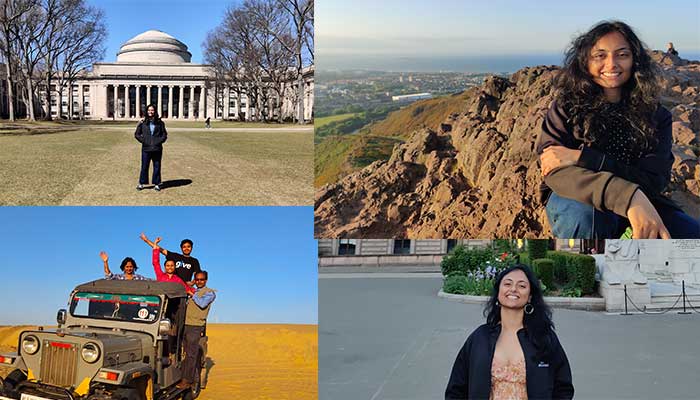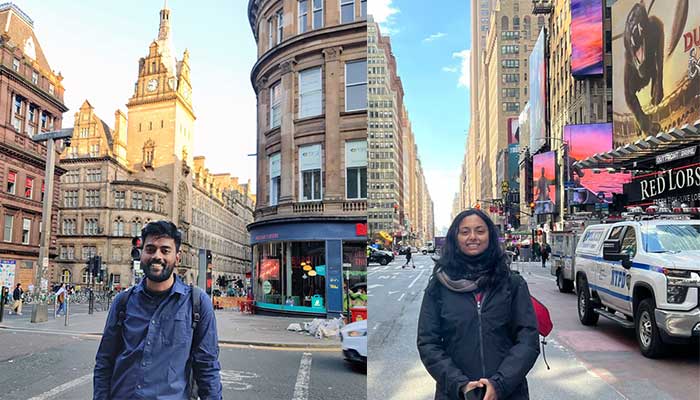MS by Research students at IIITH, Bipasha Sen and Aditya Agarwal have earned bragging rights with their admission into the coveted Electrical Engineering and Computer Science program at MIT. They give a detailed account of what it takes.
In MIT’s Electrical Engineering and Computer Science department, 24% of graduate students are women. Bipasha Sen, a former MS by Research student in Computer Science is one of them. What’s interesting is that when she applied for a PhD for the first time in 2020, not one of the 8-10 colleges in her shortlist (MIT being one of them) accepted her application. “That is when I realised how competitive PhD in ML/AI had become as I could not bag even a single acceptance despite applying broadly,” she remarks. As a Microsoft employee, she had been donning many different hats “from front-end and backend development, to sales, from project management and marketing to research, and also mentorship”. The full-time position at Microsoft had been secured via an initial research internship which she says was thanks to an impressive resume. As an undergrad studying Computer Engineering at the University of Mumbai, the Nerdness, as she called herself, had suitably demonstrated her programming prowess by learning several languages, creating games, participating in multiple hackathons and also successfully developing an online cloud storage network that hosted many students from her college. Revealing the profound influence the movie “Social Network” had on her, she explains her creation theBhaad.com as a precursor to Google Drive. “This was before Google Drive became popular in India and everyone used Facebook Groups.”
From Industry To Academia
At Microsoft, Bipasha discovered that her initial inclination to pursue fundamental research had become a distant dream with the company’s focus primarily on applied research. So she did what would be unthinkable for many – started from scratch. She began with a part-time collaboration at the IIITH Speech Lab under Prof. Anil Kumar Vuppala as her advisor in 2020. “It led to my first international peer reviewed conference – the IEEE Spoken Language Technology Workshop,” she says. With zero acceptances for a PhD admission, she took the plunge as a full-time researcher. “I had been following Prof. C.V. Jawahar’s work in computer vision for a while and I got the greatest opportunity to become part of his lab, co-advised by Prof. Vinay Namboodiri,” she narrates. When she published her first computer vision paper in 2021 at the British Machine Vision Conference (BMVC), she simultaneously decided to convert to an MS by Research student. “I was also all set to reapply for a PhD that year when I received the best possible advice ever from Prof. Namboodiri,” says Bipasha. “He simply said, ‘Don’t’, and asked me to wait just one more year, seeing that I was on my way to publishing more impactful work that year and improving my profile ten-fold.”
Beefing Up The Resume
Opting for a course on Mobile Robotics taught by Prof. Madhav Krishna, Bipasha soon found herself pursuing an independent study under him towards the end of 2021. “We placed third in a prestigious international robotics competition, OCRTOC – a benchmark for grasping and manipulation, held at the International Conference on Robotics and Automation (ICRA) 2022.” Many more collaborations with Prof. Krishna followed leading to paper presentations at ICRA 2023, CASE 2023 – an IEEE International Conference on Automation Science and Engineering, and others. By the 2022 application cycle, Bipasha had developed a unique research inclination that lay at the intersection of perception and robotics. Armed with solid recommendation letters from her IIITH professors, plus all the impressive research work, Bipasha was accepted under doctoral advisor Prof. Pulkit Agarwal of the Computer Science and Artificial Intelligence Lab (CSAIL) at MIT’s EECS department, making the initial heartache worth its while.


Aditya’s Approach
“I’m not sure if it qualifies as an ‘achievement’ that can be written about,” begins Aditya Agarwal who has been accepted for a PhD at CSAIL too. He will be working in the Learning and Intelligent Systems Group led by Professors Leslie Kaelbling and Tomas Lozano-Perez. The group is part of Robotics@MIT and the Embodied Intelligence groups whose focus is on interdisciplinary research to discover the underlying design of artificially intelligent robots. “Specifically my work will be at the intersection of perception and task and motion planning, with the overarching goal of building general purpose and autonomous robots that can seamlessly integrate with the human world,” explains Aditya.
Reviving Research Interest
Prior to his stint at IIITH as an MS by Research student, Aditya was a data scientist at Microsoft Bing who worked in the People Also Ask Team on NLP and Deep Learning that helped display related questions and answers on Bing’s search page for any query. With opportunities at the workplace to participate in several hackathons, he soon found his research interest getting rekindled. “One hackathon in particular, organised by the Microsoft retail team, required us to predict outfits that matched given descriptions. This experience sparked my fascination with computer vision,” he narrates. What began as an initial exploration of opportunities in computer vision within Microsoft led to the realisation that his true passion lay in working on more fundamental problems in academia. It certainly helped that it was an exciting time when generative models like GANs and VAEs were gaining popularity and showing tremendous potential in the field of robotics, especially in improving the perception and representation capabilities of robotic systems.
How Research Took Off
With a list of relevant academic labs in India that focused on computer vision, Aditya zoomed in on the CVIT Lab at IIITH. “Prof. CV Jawahar’s group’s focus on problems in lipreading and talking-face generation intrigued me,” he says, adding that he also received vital feedback not only about the esteemed Professor’s expertise and prominence in the research community but also about the excellent research culture at IIITH. While Aditya’s intent was to join as a full-time Research Assistant in the audio-visual group of CVIT under Prof. Jawahar and Prof. Vinay Namboodiri (who is his co-advisor and a senior lecturer from the University of Bath), he was strongly advised to apply for an MS degree instead. “I wanted to apply for PhD admissions the same year but they recommended that I utilise the full extent of research facilities here so that I could apply for a PhD with a stronger profile next year.” That piece of advice proved to be extremely fruitful for Aditya with the bulk of his research work materialising in the 2nd year of the MS program.
Working Up The Profile
In the audio-visual group, Aditya worked on projects of great social importance that address the challenges faced by individuals with hearing and speech-related disabilities. His research in the areas of talking-face generation, lipreading, and video generation resulted in publications at top-rated venues. “Additionally, during my first year, I took a course on Mobile Robotics, which sparked my interest in 3D computer vision and its applications in robotics,” he says. An independent study project that he began with a team of 4 under the guidance of Prof. Madhava Krishna from the Robotics lab saw them in a podium finish in an international robotics competition focused on tabletop manipulation. “The win significantly bolstered my PhD application,” he states. During this time, Aditya also established a collaboration with Prof. Srinath Sridhar from Brown University at the robotics lab, where they worked on unposed 3D shape completion. By the time the PhD application deadline loomed, in addition to bragging rights for the robotics competition, he had co-authored six top-rated publications and maintained an exceptional GPA.
Tips and Tricks
Despite building up an impressive portfolio of works, Aditya remarks that he was uncertain about securing a PhD admission from a top school. “It’s because many highly qualified individuals with better research experience had faced rejection”. But with both Bipasha and Aditya having cracked their way into the extremely competitive CSAIL at MIT, it’s only fair to ask now what works and what doesn’t? “Unlike other schools, US institutions place significant emphasis on the motivation for research and having a solid research direction and plan,” says Aditya whose secret sauce lay in a well-crafted research statement that not only summarised his research work with proposed directions for future work but also revealed how his current study aligned in general with his vision. Bipasha reveals that she closely followed and was intrigued by the research published by the professors by MIT. “I designed my MS research in a way that it aligned with the research at MIT so that when I applied there, I would be relevant,” she says. According to the duo, the second key ingredient lies in the strength of recommendation letters. Both received glowing endorsements from the esteemed trio of Prof. Jawahar, Prof. Namboodiri and Prof. Krishna. “Research papers (preferably published) are proofs that indeed what you and your advisors say are true. I wouldn’t place it too high in the list of things that make or break your application, but a prolific research profile certainly sets you apart. Grades are not as important (I had 10 GPA in my MS though just to be safe!),” states Bipasha with an example of what she calls a ‘good’ profile consisting of a perfect application and ‘okayish’ grades.
Carpe Diem Carpe Interview
Part two of the selection process involves interviews. Having received feedback that his profile was one of the strongest from India, Aditya mentions that it gave him the much-needed encouragement and confidence required for what he terms, nerve-wracking interviews that lay ahead. “I spent many hours practising my research pitch, pondering deeply about the research problems, identifying limitations in my previous works and going through the research works of my potential advisors with a fine-toothed comb,” he says. Although the initial focus of the interviews is on the research direction, technical questions about projects and problem-solving on the spot, Aditya discovered that the interactions quickly evolved into engaging research discussions. “I thoroughly enjoyed the interviews, except for one or two minor hiccups,” he affirms. According to Bipasha, once a professor shows interest in your application, an interaction in the form of a ‘casual chat’ or an ‘interview’ can take place. “It is good to never underestimate the importance of either because it is an indication that you are at the university’s gate,” she says, adding, “The professor can either open or close the gate for you. You could get 20 minutes or 2-3 hours to make your case. Make sure you put your best foot forward.”
With interesting discussions that were had with Prof. Pulkit as well as other professors from other ivy league institutes, Bipasha had a strong feeling of having made the cut. As for Aditya, with seven Ph.D. acceptances from top universities, he ultimately chose to join MIT due to its extensive robotics group and collaborative environment.
Sarita Chebbi is a compulsive early riser. Devourer of all news. Kettlebell enthusiast. Nit-picker of the written word especially when it’s not her own.

